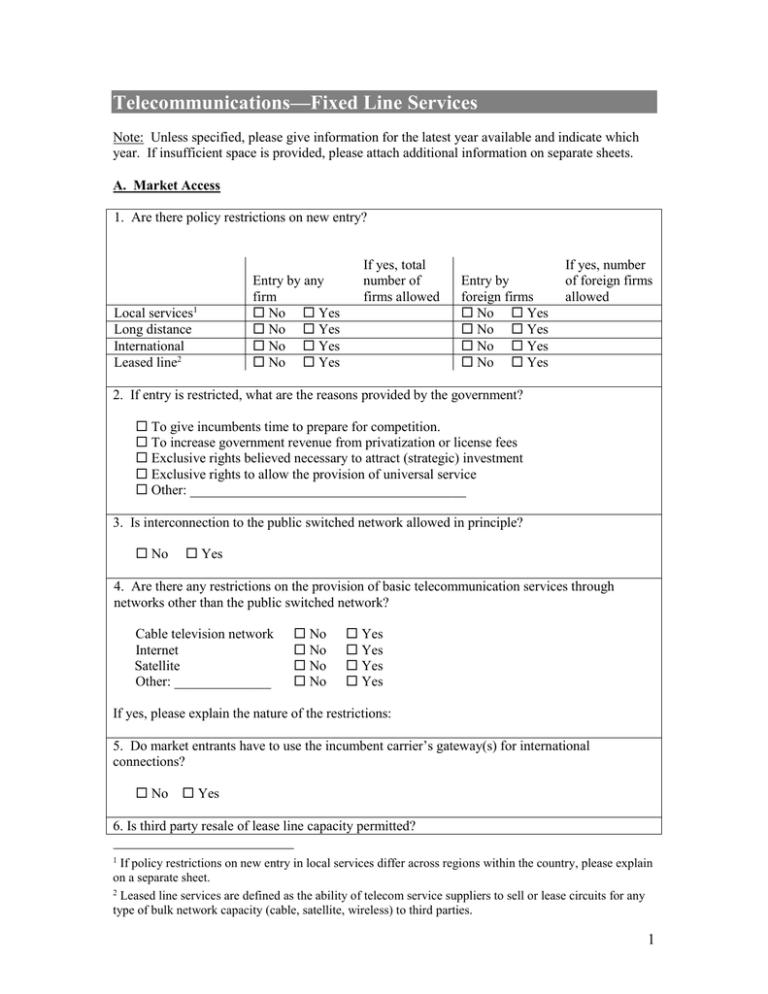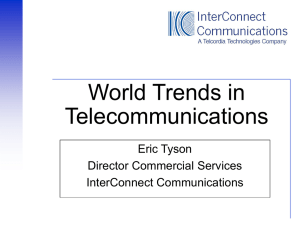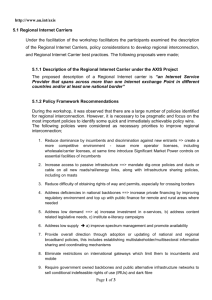Telecommunications—Fixed Line Services
advertisement

Telecommunications—Fixed Line Services Note: Unless specified, please give information for the latest year available and indicate which year. If insufficient space is provided, please attach additional information on separate sheets. A. Market Access 1. Are there policy restrictions on new entry? Local services1 Long distance International Leased line2 Entry by any firm No Yes No Yes No Yes No Yes If yes, total number of firms allowed Entry by foreign firms No Yes No Yes No Yes No Yes If yes, number of foreign firms allowed 2. If entry is restricted, what are the reasons provided by the government? To give incumbents time to prepare for competition. To increase government revenue from privatization or license fees Exclusive rights believed necessary to attract (strategic) investment Exclusive rights to allow the provision of universal service Other: ________________________________________ 3. Is interconnection to the public switched network allowed in principle? No Yes 4. Are there any restrictions on the provision of basic telecommunication services through networks other than the public switched network? Cable television network Internet Satellite Other: ______________ No No No No Yes Yes Yes Yes If yes, please explain the nature of the restrictions: 5. Do market entrants have to use the incumbent carrier’s gateway(s) for international connections? No Yes 6. Is third party resale of lease line capacity permitted? 1 If policy restrictions on new entry in local services differ across regions within the country, please explain on a separate sheet. 2 Leased line services are defined as the ability of telecom service suppliers to sell or lease circuits for any type of bulk network capacity (cable, satellite, wireless) to third parties. 1 No Domestic Yes International No Yes If yes, please specify the designated countries: ________________________________ B. Ownership 7. Is private ownership in the provision of services allowed? Local services Long distance International Leased line Existing operators No Yes No Yes No Yes No Yes Maximum private equity permitted (%) New entrants No Yes No Yes No Yes No Yes Maximum private equity permitted (%) 8. Is foreign ownership in the provision of services allowed? Local services Long distance International Leased line Existing operators No Yes No Yes No Yes No Yes Maximum foreign equity permitted (%) New entrants No Yes No Yes No Yes No Yes Maximum foreign equity permitted (%) 9. Are there any restrictions on companies offering services in more than one market segment (local, long distance, international, leased line)? No Yes If yes, please explain the nature of these restrictions: ______________________________ C. Market Structure 10. Please list the characteristics of all facilities-based operators providing local services (starting with the incumbent PTO). Name of firm Year the firm first offered services Revenue Owners of capital and their respective shares (domestic/foreign) 2 11. Please list the characteristics of all facilities-based operators providing long distance services (starting with the incumbent PTO). Name of firm Year the firm first offered services Revenue Owners of capital and their respective shares (domestic/foreign) 12. Please list the characteristics of all facilities-based operators providing international services (starting with the incumbent PTO). Name of firm Year the firm first offered services Revenue Owners of capital and their respective shares (domestic/foreign) 13. Please list the characteristics of all facilities-based operators providing leased line services (starting with the incumbent PTO). Name of firm Year the firm first offered services Revenue Owners of capital and their respective shares (domestic/foreign) 14. If third party resale of leased-line capacity is permitted, how many resellers are in the market? Domestic:_____ International:_____ D. Regulation 15. Institutional status of sector regulator a) When was the regulator established? ___________ b) Is the sector regulator independent from the incumbent PTO? No Yes c) If yes to b), is the regulator independent from the sector ministry? No Yes d) How is the sector regulator financed? License and other fees ___% State budget ___% Other (___________): ___% 3 e) How many technical and economic professionals are employed? ________ 16. Please indicate regulatory responsibilities for the following functions: Operator Ministry Regulator Other (specify) Licensing Setting of interconnection rates Regulation of retail tariffs Dispute settlement and arbitration Regulation of cable television 17. How are licenses for fixed line services allocated? a) If the number of providers is not restricted by policy, specify the main conditions new entrants must fulfill. Payment of license fee (indicate amount in local currency: ________) Other: _____________________ b) If the number of providers is limited by policy, through what mechanism are licenses allocated? Competitive tender Discretionary decision by the licensing authority Other:_______________________________ c) Do licenses foresee specific network roll-out plans? No Yes d) Are foreign firms subject to different licensing requirements from domestic firms? No Yes If yes, please specify what additional requirements have to be met by foreign operators: e) Do licenses grant exclusivity periods? No Yes If yes, please indicate for the relevant market segments (local, long distance, international, leased line) when the exclusivity period will expire? _______________ 18. Regulation of network interconnection a) How are interconnection agreements among carriers determined? Private negotiations between parties Private negotiations, but general terms determined by regulatory agency Detailed terms of interconnection determined by the regulatory agency Other: ________________________________ 4 b) Which of the following aspects of interconnection are set by the regulatory agency? Technical standards Procedures for interconnection Time frames for interconnection Points of interconnection Price of interconnection Other: ______________ c) Are interconnection agreements required to be made public? No Yes d) Which of the following interconnection pricing rules are applied in your country? Reciprocal pricing3 Unbundling4 Imputation5 Other: _____________ 19. End-user tariffs a) How are end-user tariffs determined in your country? By market forces (i.e., not regulated) Price caps established by the regulator Rate of return regulation Other: _____________________ b) Is there a plan to rebalance tariffs in your country?6 No Yes If yes, please indicate when this plan is scheduled to be completed: ____________ 20. Public consultation and transparency a) Which of the following are consulted in advance of regulatory decisions? Service providers Consumer groups User industries 3 Reciprocal pricing requires that all networks charge the same amount to terminate calls coming from other networks. 4 An ‘unbundling’ policy requires the dominant network operator to sell network components independently of each other, so that rival networks are not forced to buy services they do not need. 5 Imputation rules are designed to eliminate any markup on services components sold to competing firms over and above the implicit charges for internal use – and should tend to equalize prices charged by direct competitors. 6 Tariff rebalancing may take place when a dominant carrier provides both domestic and long distance/international services. It usually takes the form of the elimination of cross-subsidies from long distance/international services to the local segment of the domestic market. 5 Other: _____________________ b) How are laws and regulatory decisions made public? Published on the regulator’s website Published in an official gazette Other: _____________________ E. Regional Integration Agreements in Fixed Line Services 21. Please indicate if there are any preferential arrangements affecting fixed line services, and list the preferential measures.7 Name of agreement Partner country(s) in agreement Date of entry into force Preferential measures F. Past and Future Changes in Policy 22. Please indicate major changes in market access policies, ownership rules, and regulation since 1990 (e.g., privatization of incumbent operator, introduction of competition, creation of an independent regulatory agency). Please attach copies of laws and regulations. Area of policy change (market access, ownership or regulation) Year of policy change Description of policy change 23. Please indicate announced or anticipated changes in the same areas. Area of policy change (market access, ownership or regulation) Anticipated date Description of policy change 7 Please, specify how the treatment of fixed line service suppliers of member countries of the agreement differs from the treatment of fixed line service suppliers of non-member countries. 6 G. Universal Service 24. How does the government define universal service (or universal access)? 25. What are the policy instruments used to pursue the universal service objective? Roll-out obligations in services licenses Subsidies to operator(s), e.g., from universal service funds or state budgets Vouchers for target consumers Other: _________________________________ 26. On which service suppliers are universal service obligations imposed? Incumbent operator Private operators offering local services Private operators offering long distance and international services Other:__________________________________ H. Employment 27. Main employment indicators (for the years 1990-2000) How many people are employed in the provision of fixed line services? __________ What share of the total labor force is employed in this sector? ____________ What share of workers in this sector is employed by state-owned operators? ___________ What share of workers in this sector is employed by foreign-owned operators? __________ What is the annual average wage in this sector?____________ If time-series data from 1990 to 2000 is not available, please collect indicators for the years 1990, 1995 and 2000. I. Investment 28. Investment indicators (for the years 1990-2000) What is the total amount of investment in fixed line services? _____________ What is the total amount of foreign direct investment in this sector? ___________ What is the total stock of foreign direct investment in this sector? ___________ If time-series data from 1990 to 2000 is not available, please collect indicators for the years 1990, 1995 and 2000. 7 J. Prices 29. Please indicate the prices of the following services. Where relevant, distinguish between peak and off-peak charges. For a comprehensive assessment of telecommunications performance, it would be extremely useful to have historical data on prices for the various services. If time series data are available, please attach them separately (preferably electronically). Service Installation charges Monthly subscription for business Monthly subscription for households 3-minute local call 3-minute domestic long distance call 3-minute call to Sao Paulo 3-minute call to Miami Average interconnection charge with main operator of local services Monthly leased line charges (capacity:____________) Price (in local currency) Date Comments K. Quality and Access to Services 30. Please fill in the following indicators of quality and access to services. If time series data are available, please attach them separately (preferably electronically). Indicator Total number of main telephone lines in the country Number of main telephone lines in rural areas Number of main telephone lines in urban areas Number of payphones and/or call centers Waiting time for installation of basic telephone services Waiting list for installation of basic telephone services Percentage of network that is digitized Percentage of unsuccessful calls Are callback services available? Percentage of households with access to cable television Value Date Comments No Yes If yes, please since when? _____ 8 Please, provide the name and contact information of the respondent of this questionnaire, or of a specialist from whom we can obtain clarifications if necessary. Name_________________________________________________________________________ Telephone_____________________________________________________________________ Fax___________________________________________________________________________ E-mail address:__________________________________________________________________ Telecommunications—Mobile Services 9 Note: Unless specified, please give information for the latest year available and indicate which year. If insufficient space is provided, please attach additional information on separate sheets. A. Market Access 1. Are there policy restrictions on new entry?8 Entry by any firm No Yes No Yes Analogue mobile Digital mobile If yes, total number of firms allowed Entry by foreign firms No Yes No Yes If yes, number of foreign firms allowed 2. If entry is restricted, what are the reasons provided by the government? To give incumbents time to prepare for competition To increase government revenue from privatization or license fees Exclusive rights believed necessary to attract (strategic) investment Limited availability of radio frequencies Other: ________________________________________ B. Ownership 3. Is private ownership in the provision of services allowed? Analogue mobile Digital mobile Existing operators No Yes No Yes Maximum private equity permitted (%) New entrants No Yes No Yes Maximum private equity permitted (%) 4. Is foreign ownership in the provision of services allowed? Analogue mobile Digital mobile Existing operators No Yes No Yes Maximum foreign equity permitted (%) New entrants No Yes No Yes Maximum foreign equity permitted (%) C. Market Structure 5. Please list the characteristics of all operators providing analogue mobile services. 8 If policy restrictions on new entry in analogue or digital mobile differ across regions within the country, please explain on a separate sheet. 10 Name of firm Year the firm first offered services Market share Technology Owners of capital and their respective shares (domestic/foreign) 6. Please list the characteristics of all operators providing digital mobile services. Name of firm Year the firm first offered services Technology (e.g., GSM, CMDA) Market share Owners of capital and their respective shares (domestic/foreign) D. Regulation 7. Please indicate regulatory responsibilities for the following functions: Operator Ministry Regulator Other (specify) Licensing Setting of interconnection rates Regulation of retail tariffs Dispute settlement and arbitration Spectrum Allocation 8. How are licenses for mobile services allocated? a) If the number of operators is not restricted by policy, specify the main conditions new entrants must fulfill. Payment of service license fee (indicate amount in local currency: ________) Other: _______________________________ b) If the number of operators is limited by policy, through what mechanism are service licenses allocated? Competitive tender Discretionary decision by the licensing authority Other:_______________________________ c) Are foreign firms subject to different licensing requirements from domestic firms? 11 No Yes If yes, please specify what additional requirements have to be met by foreign operators: d) Do licenses foresee specific network roll-out plans? No Yes e) Do licenses grant exclusivity periods? No Yes If yes, please indicate for the relevant market segments (digital, analogue) when the exclusivity period will expire? _______________ 9. Allocation of radio spectrum a) If radio frequencies are not awarded with the service license, through what mechanism are licenses for radio frequencies allocated? Auction Discretionary decision by the licensing authority First come, first served Other:_____________________________ b) Is there a separate fee for radio frequency licenses? No Yes If yes, please indicate the average fee paid by operators: _______ 10. Regulation of network interconnection a) How are interconnection agreements between mobile and fixed-line carriers determined? Private negotiations between parties Private negotiations, but general terms determined by regulatory agency Detailed terms of interconnection determined by the regulatory agency Other: ________________________________ b) How are interconnection agreements among mobile carriers determined? Private negotiations between parties Private negotiations, but general terms determined by regulatory agency Detailed terms of interconnection determined by the regulatory agency Other: ________________________________ c) Which of the following aspects of interconnection are set by the regulatory agency? Technical standards Procedures for interconnection Time frames for interconnection Points of interconnection Price of interconnection 12 Other: ______________ d) Are interconnection agreements required to be made public? No Yes e) Which of the following interconnection pricing rules are applied in your country? Reciprocal pricing9 Unbundling10 Imputation11 Other: _____________ f) Are mobile carriers allowed to charge for incoming mobile calls? No Yes If yes, do mobile carriers actually charge for incoming calls? No Yes 11. How are end-user tariffs for mobile services determined in your country? By market forces (i.e., not regulated) Price caps established by the regulator Rate of return regulation Other: _____________________ 12. Public consultation and transparency a) Which of the following are consulted in advance of regulatory decisions? Service providers Consumer groups User industries Other: _____________________ b) How are laws and regulatory decisions made public? Published on the regulator’s website Published in an official gazette Other: _____________________ E. Regional Integration Agreements in Mobile Services 13. Please indicate if there are any preferential arrangements affecting mobile services, and list the preferential measures.12 9 Reciprocal pricing requires that all networks charge the same amount to terminate calls coming from other networks. 10 An ‘unbundling’ policy requires the dominant network operator to sell network components independently of each other, so that rival networks are not forced to buy services they do not need. 11 Imputation rules are designed to eliminate any markup on services components sold to competing firms over and above the implicit charges for internal use – and should tend to equalize prices charged by direct competitors. 13 Name of agreement Partner country(s) in agreement Date of entry into force Preferential measures F. Past and Future Changes in Policy 14. Please indicate major changes in market access policies, ownership rules, and regulation since 1990 (e.g., grant of additional mobile licenses, relaxation of ownership rules). Area of policy change (market access, ownership or regulation) Year of policy change Description of policy change 15. Please indicate announced or anticipated changes in the same areas. Among other things, describe the government’s plans for the introduction of third generation mobile services. Area of policy change (market access, ownership or regulation) Anticipated date Description of policy change G. Employment 16. Main employment indicators (for the years 1990-2000) How many people are employed in the provision of mobile services? _________ What share of the total labor force is employed in this sector? __________ What share of workers in this sector is employed by state-owned operators? ___________ What share of workers in this sector is employed by foreign-owned service providers? ____ What is the annual average wage in this sector?_____________ 12 Please, specify how the treatment of mobile service suppliers of member countries of the agreement differs from the treatment of mobile service suppliers of non-member countries. 14 If time-series data from 1990 to 2000 is not available, please collect indicators for the years 1990, 1995 and 2000. H. Investment 17. Investment indicators (for the years 1990-2000) What is the total amount of investment in mobile services? _____________ What is the total amount of foreign direct investment in this sector? ___________ What is the total stock of foreign direct investment in this sector? ___________ If time-series data from 1990 to 2000 is not available, please collect indicators for the years 1990, 1995 and 2000. I. Prices 18. Please indicate the prices of the following services. Where relevant, distinguish between peak and off-peak charges. For a comprehensive assessment of mobile performance, it would be extremely useful to have historical data on prices for the various services. If time series data are available, please attach them separately (preferably electronically). Service Acquisition of handset Monthly rental charges 3-minute domestic call 3-minute call to Sao Paulo 3-minute call to Miami Average roaming charges Average interconnection charge with fixed network Average interconnection charge between mobile networks Price (in local currency) Date Comments J. Quality and Access to Services 19. Please fill in the following indicators of quality and access to services. If time series data are available, please attach them separately (preferably electronically). Indicator Total number of mobile subscribers in the country Number of mobile subscribers in rural areas Waiting period for acquisition of handset and initiation of service Percentage of unsuccessful Value Date Comments 15 calls Please, provide the name and contact information of the respondent of this questionnaire, or of a specialist from whom we can obtain clarifications if necessary. Name_________________________________________________________________________ Telephone_____________________________________________________________________ Fax___________________________________________________________________________ E-mail address:__________________________________________________________________ Telecommunications—Internet services Note: Unless specified, please give information for the latest year available and indicate which year. If insufficient space is provided, please attach additional information on separate sheets. 16 A. Market Access 1. Are there policy restrictions on new entry of Internet service providers? If yes, total number of firms allowed Entry by any firm No Yes Entry by foreign firms No Yes If yes, number of foreign firms allowed 2. If entry is restricted, what are the reasons provided by the government? To give incumbents time to prepare for competition To increase government revenue from privatization or license fees Other: ________________________________________ B. Ownership 3. Is private ownership in the provision of services allowed? Maximum private equity permitted (%) Existing operators No Yes New entrants No Yes Maximum private equity permitted (%) 4. Is foreign ownership in the provision of services allowed? Maximum foreign equity permitted (%) Existing operators No Maximum foreign equity permitted (%) New entrants No Yes Yes C. Market Structure 5. a) What is the total number of Internet service providers? _________ b) How many Internet service providers are related to telecom operators? ___________ 6. Please list the characteristics of the six largest Internet services providers. Name of firm Year the firm first offered services Market share Owners of capital and their respective shares (domestic/foreign) D. Regulation 17 7. Licensing regime a) Is there a licensing regime for Internet service providers? No Yes b) If yes to a), which governmental agency issues licenses? ________________ c) If yes to a), please specify the main conditions new entrants have to fulfill: d) Are foreign firms subject to different licensing requirements from domestic firms? No Yes If yes, please specify what additional requirements have to be met by foreign operators: 8. Infrastructure and interconnection a) Are Internet service providers allowed to build their own networks? No Yes b) Are Internet service providers (other than the incumbent or affiliates) allowed to own or lease their own international data gateways? No Yes c) How are interconnection agreements among Internet service providers regulated? Private negotiations between parties Private negotiations, but general terms determined by regulatory agency Detailed terms of interconnection determined by the regulatory agency Other: ________________________________ d) How many peering points (locations where national and regional Internet traffic can be exchanged) are available? Private_________ Public____________ 9. Are there any policy initiatives to bolster Internet use? No Yes If yes, a) when were they introduced? ___________ b) what do they cover? Plan to introduce flat-rate access Discount local access charges for Internet use Other: ________________________________ 10. Public consultation and transparency a) Which of the following are consulted in advance of regulatory decisions? Service providers Consumer groups User industries Other: _____________________ 18 b) How are laws and regulatory decisions made public? Published on the regulator’s website Published in an official gazette Other: _____________________ E. Regional Integration Agreements in Internet Services 11. Please indicate if there are any preferential arrangements affecting internet services, and list the preferential measures.13 Name of agreement Partner country(s) in agreement Date of entry into force Preferential measures F. Past and Future Changes in Policy 12. Please indicate major changes in market access policies, ownership rules, and regulation since 1985 (e.g., grant of additional licenses for Internet services, relaxation of ownership rules). Area of policy change (market access, ownership or regulation) Year of policy change Description of policy change 13. Please indicate announced or anticipated changes in the same areas. Area of policy change (market access, ownership or regulation) Anticipated date Description of policy change 13 Please, specify how the treatment of internet service suppliers of member countries of the agreement differs from the treatment of internet service suppliers of non-member countries. 19 G. Employment 14. Main employment indicators (for the years 1990-2000) How many people are employed in the provision of Internet and data services? _________ What share of the total labor force is employed in this sector? __________ What share of workers in this sector is employed by state-owned service providers? ______ What share of workers in this sector is employed by foreign-owned service providers? ____ What is the average annual wage in this industry?_________ If time series data on these employment indicators are available, please attach them separately. H. Investment 15. Investment indicators (for the years 1990-2000) What is the total amount of investment in Internet services? _____________ What is the total amount of foreign direct investment in this sector? ___________ What is the total stock of foreign direct investment in this sector? ___________ If time-series data from 1990 to 2000 is not available, please collect indicators for the years 1990, 1995 and 2000. I. Prices 16. Please indicate the prices of the following services. Where relevant, distinguish between peak and off-peak charges. For a comprehensive assessment of Internet performance, it would be extremely useful to have historical data on prices for the various services. If time series data are available, please attach them separately (preferably electronically). Service Average monthly charges for low bandwidth residential Internet access (Capacity:_________) Price (in local currency) Date Comments Additional (per minute) local telephone charges (if relevant) Average monthly charges for high bandwidth business Internet access (Capacity:_________) Additional connection charges (if relevant) I. Quality and Access to Services 17. Please fill in the following indicators of quality and access to services. 20 Indicator Number of Internet hosts Number of household subscribers Total number of Internet users Number of users that access the Internet via the fixed telephone network Number of users that access the Internet via leased lines Number of users that access the Internet via the cable network Annual value of e-commerce transactions Value Date Comments Please, provide the name and contact information of the respondent of this questionnaire, or of a specialist from whom we can obtain clarifications if necessary. Name_________________________________________________________________________ Telephone_____________________________________________________________________ Fax___________________________________________________________________________ E-mail address:__________________________________________________________________ 21 22




